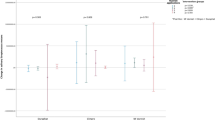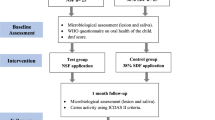Abstract
Objectives
The aim of this study was to compare the antibacterial activity of fluoride varnishes containing different agents in children with severe early childhood caries (S-ECC).
Materials and methods
The study was conducted in 92 children with S-ECC. Patients who completed dental treatment under general anaesthesia were included in the study. Patients were divided randomly into four groups: 5% sodium fluoride (SF) control group (n = 23), 5% SF with tricalcium phosphate (TCP) (n = 23), 5% SF with xylitol-coated calcium and phosphate (CXP) (n = 23) and 5% SF with casein phosphopeptide-amorphous calcium phosphate (CPP-ACP) (n = 23). Saliva mutans streptococci (MS) and lactobacilli (LB) levels were evaluated by taking saliva samples at baseline (T0), 1 month (T1) and 3 months (T2) after treatment.
Results
All groups showed a significant decrease in MS and LB levels at T1 (P < 0.05) except the CXP group. Only the TCP group exhibited significantly decrease MS and LB levels indicating less than 105 CFU at both T1 and T2 compared with the other groups (P < 0.05).
Conclusion
Fluoride varnish with TCP provided significantly more reduction in MS and LB levels than other fluoride varnishes.
Clinical relevance
Fluoride varnish with TCP had a significant antibacterial effect against cariogenic bacteria until the end of the third month. Long lasting antibacterial effect provides additional advantage for reducing bacteria levels in children.
Clinical Trials registration number
NCT03625310



Similar content being viewed by others
References
Qin M, Li J, Zhang S, Ma W (2008) Risk factors for severe early childhood caries in children younger than 4 years old in Beijing, China. Pediatr Dent 30:122–128
AAPD (2017) Policy on early childhood caries (ECC): classifications, consequences, and preventive strategies. Pediatr Dent 39(6):59–61
Seow WK, Clifford H, Battistutta D, Morawska A, Holcombe T (2009) Case control study of early childhood caries in Australia. Caries Res 43:25–35
Barber LR, Wilkins EM (2002) Evidence-based prevention, management, and monitoring of dental caries. J Dent Hyg 76:270–275
Weintraub JA, Ramos-Gomez F, Jue B, Shain S, Hoover CI, Featherstone JD et al (2006) Fluoride varnish efficacy in preventing early childhood caries. J Dent Res 85(2):172–176
Berkowitz RJ (1996) Etiology of nursing caries: a microbiologic perspective. J Public Health Dent 56:51–54
Berkowitz RJ, Moss M, Billings RJ, Weinstein P (1997) Clinical outcomes for nursing caries treated using general anaesthesia. ASDC J Dent Child 64:210–211 8
Gregory RL, Al-Rahman AM, Avery DR (1998) Effect of restorative treatment on mutans streptococci and lgA antibodies. Pediatr Dent 20:273–277
AAPD (2013) Guideline on fluoride therapy. Clinical guidelines 36(6):167–170
Autio-Gold JT, Courts F (2001) Assessing the effect of fluoride varnish on early enamel carious lesions in the primary dentition. J Am Dent Assoc 132(9):1247–1253 quiz 1317-1248
Borutta A, Kunzel W, Rubsam F (1991) The caries-protective efficacy of 2 fluoride varnishes in a 2-year controlled clinical trial. Dtsch Zahn Mund Kieferheilkd Zentralbl 79(7):543–549
Jeevarathan J, Deepti A, Muthu MS, Rathna Prabhu V, Chamundeeswari GS (2007) Effect of fluoride varnish on Streptococcus mutans counts in plaque of caries-free children using Dentocult SM strip mutans test: a randomized controlled triple blind study. J Indian Soc Pedod Prev Dent 25(4):157–163
Baygin O, Tuzuner T, Kusgoz A, Senel AC, Tanriver M, Arslan I (2014) Antibacterial effects of fluoride varnish compared with chlorhexidine plus fluoride in disabled children. Oral Health Prev Dent 12(4):373–382
Shah S, Bhaskar V, Venkataraghavan K, Choudhary P, Ganesh M, Trivedi K (2013) Efficacy of silver diamine fluoride as an antibacterial as well as antiplaque agent compared to fluoride varnish and acidulated phosphate fluoride gel: an in vivo study. Indian J Dent Res 24(5):575–581
Lewinstein I, Stoleru-Baron J, Block J, Kfir A, Matalon S, Ormianer Z (2013) Antibacterial activity and tensile strength of provisional cements modified with fluoridecontaining varnish. Quintessence Int 44(2):107–112
Pitchika V, Kokel CJ, Andreeva J, Crispin A, Hickel R, Kühnisch J, Heinrich-Weltzien R (2013) Effectiveness of a new fluoride varnish for caries prevention in pre-school children. J Clin Pediatr Dent 38(1):7–12
Rirattanapong P, Vongsavan K, Saengsirinavin C, Pornmahala T (2014) Effect of fluoride varnishes containing tri-calcium phosphate sources on remineralization of initial primary enamel lesions. Southeast Asian J Trop Med Public Health 45(2):499–504
Yu OY, Zhao IS, Mei ML, Lo EC, Chu CH (2018) Effect of silver nitrate and sodium fluoride with tri-calcium phosphate on Streptococcus mutans and demineralised dentine. Int J Mol Sci 19(5):E1288
Samuel V, Ramakrishnan M, Halawany HS, Abraham NB, Jacob V, Anil S (2017) Comparative evaluation of the efficacy of tricalcium phosphate, calcium sodium phosphosilicate, and casein phosphopeptide – amorphous calcium phosphate in reducing Streptococcus mutans levels in saliva. Niger J Clin Pract 20:1404–1410
Pulpdent™ Corporation (2018) Products - Embrace™ Varnish - Product Review https://www.pulpdent.com/shop/category/embrace-varnish/. Accessed 3 Aug 2018
Mehta AB, Kumari V, Jose R, Izadikhah V (2014) Remineralization potential of bioactive glass and casein phosphopeptide-amorphous calcium phosphate on initial carious lesion: an in-vitro pH-cycling study. J Conserv Dent Jan 17(1):3–7
Bichu YM, Kamat N, Chandra PK, Kapoor A, Razmus T, Aravind NK (2013) Prevention of enamel demineralization during orthodontic treatment: an in vitro comparative study. Orthodontics (Chic) 14(1):e22–e29
Patel PM, Hugar SM, Halikerimath S, Badakar CM, Gokhale NS, Thakkar PJ, Kohli D, Shah S (2017) Comparison of the effect of fluoride varnish, chlorhexidine varnish and casein phosphopeptide- amorphous calcium phosphate (CPP-ACP) varnish on salivary Streptococcus mutans level: a six month clinical study. J Clin Diagn Res 11(8):ZC53–ZC59
Kanasi E, Johansson J, Lu SC et al (2010) Microbial risk markers for childhood caries in pediatrician’s offices. J Dent Res 89(4):378–383
Thenisch NL, Bachmann LM, Imfeld T, Leisebach Minder T, Steurer J (2006) Are mutans streptococci detected in preschool children a reliable predictive factor for dental caries risk? A systematic review. Caries Res 40(5):366–374
Fejerskov O (1997) Concepts of dental caries and their consequences for understanding the disease. Community Dent Oral Epidemiol 25:5–12
Fejerskov O, Nyvad B, Kidd EAM (2008) Pathology of dental caries. In: Fejerskov O, Kidd EAM (eds) Dental caries. The disease and its clinical management, 2nd edn. Blackwell Munksgaard, Oxford, pp 19–48
Beighton D (2005) The complex oral microflora of high-risk individuals and groups and its role in the caries process. Community Dent Oral Epidemiol 33:248–255
Sajjan PG, Nagesh L, Sajjanar M, Reddy SK, Venktesh UG (2013) Comparative evaluation of chlorhexidine varnish and fluoride varnish on plaque Streptococcus mutans count--an in vivo study. Int J Dent Hyg 11(3):191–197
Soderling E (2009) Xylitol, Mutans streptococci and dental plaque. Adv Dent Res 21:74–78
Soderling E, Hirvonen A, Karjalainen S, Fontana M, Catt D, Seppa L (2011) The effect of xylitol on the composition of the oral fluora: a pilot study. Eur J Dent 5:24–31
Marsh PD (1999) Microbiologic aspects of dental plaque and dental caries. Dent Clin N Am 43:599–614
Fejerskov O, Nyvad B (2003) Is dental caries an infectious disease? Diagnostic and treatment consequences for the practitioner. In: Schou L (ed) Nordic dentistry 2003 yearbook. Quintessence Publishing Co Ltd, Copenhagen, pp 141–152
Takahashi N, Nyvad B (2008) Caries ecology revisited: microbial dynamics and the caries process. Caries Res 42(6):409–418
Marsh PD, Martin VM (1999) Dental plaque. In: Marsh PD, Martin VM (eds) Oral microbiology. Wright, Oxford, pp 58–81
Funding
This study was funded by the Kırıkkale University Scientific Research Projects Coordination Unit (project number 2015/032).
Author information
Authors and Affiliations
Contributions
M.E.A. and A.A.O. conceived the ideas; M.E.A collected the data; M.E.A analysed the data; M.E.A. and A.A.O. led the writing.
Corresponding author
Ethics declarations
Conflict of interest
The authors declare that they have no conflict of interest.
Ethical approval
All procedures performed in studies involving human participants were in accordance with the ethical standards of the institutional and/or national research committee and with the 1964 Helsinki declaration and its later amendments or comparable ethical standards.
Informed consent
Informed consent was obtained from all individual participants included in the study.
Additional information
Publisher’s note
Springer Nature remains neutral with regard to jurisdictional claims in published maps and institutional affiliations.
Rights and permissions
About this article
Cite this article
Erkmen Almaz, M., Akbay Oba, A. Antibacterial activity of fluoride varnishes containing different agents in children with severe early childhood caries: a randomised controlled trial. Clin Oral Invest 24, 2129–2136 (2020). https://doi.org/10.1007/s00784-020-03300-w
Received:
Accepted:
Published:
Issue Date:
DOI: https://doi.org/10.1007/s00784-020-03300-w




